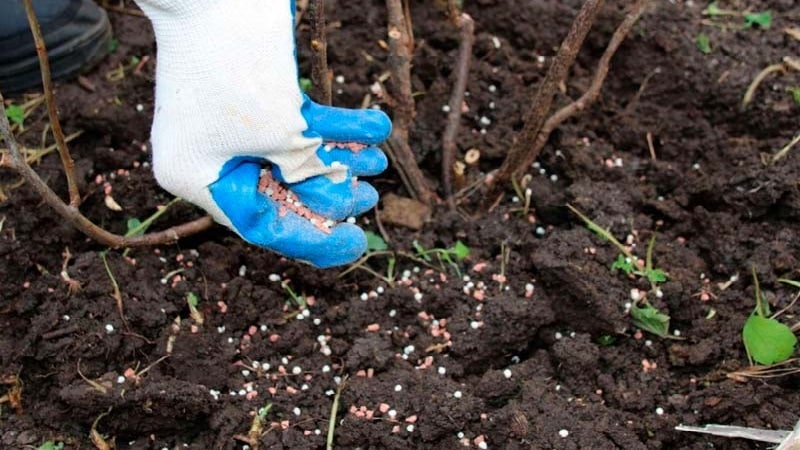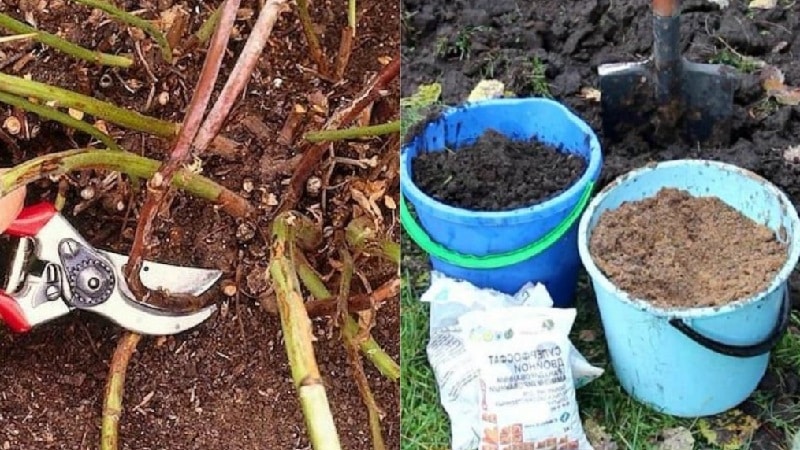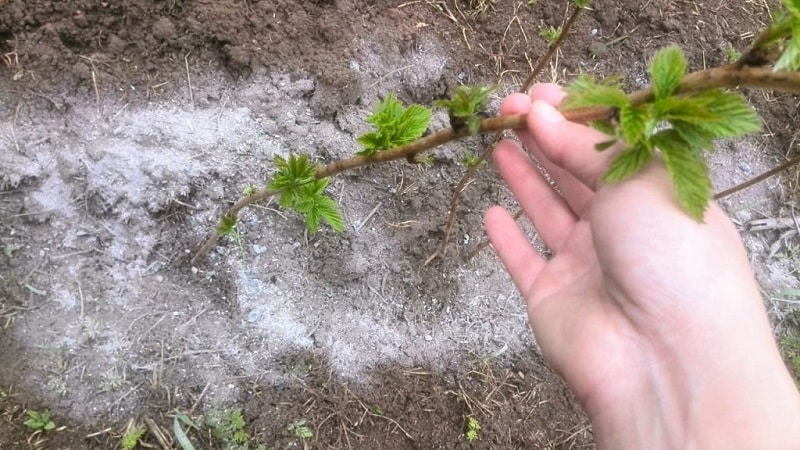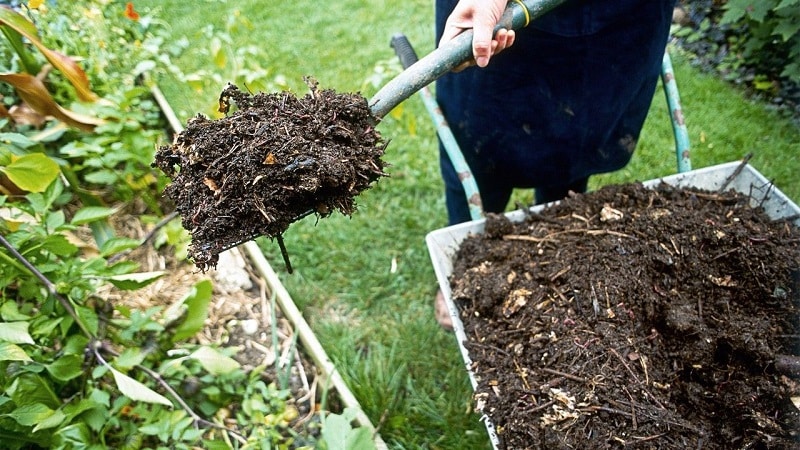How and what to feed raspberries in the fall
In order to enjoy a generous harvest of garden raspberries year after year, it is important to properly care for them and fertilize them three times a season.
In spring and summer, the berry garden is cultivated to increase productivity and protect against pests. Autumn feeding will help young shoots grow, get stronger and prepare for winter. In this article we will tell you in detail how and what to feed raspberries in the fall.
What raspberries need in the fall
Experienced summer residents determine the lack of a particular nutrient by the appearance of the plants.

For potassium, phosphorus or nitrogen deficiency microelements are primarily redirected to the upper part of the plant to the young shoots. Therefore, the color and shape of the lower tiers of leaves in mid- and late summer will tell you what the plant especially needs.
Prematurely yellowed lower leaves with downward curled edges, gray coloration of the roots indicates a lack of nitrogen. Another sign is a visible slowdown in plant growth.
Crimson, purple, violet shades of leaves of the lower tiers, poorly and slowly developing roots indicate the need to apply fertilizers containing phosphorus. The lack of this element leads to a decrease in yield.
If the edges of the leaf blade turn brown and die, which means the plant lacks potassium. A slight deficiency of potassium in the soil leads to slower growth of young stems. With an acute shortage, shortening of internodes, stunted growth and even death of shoots occurs.
When at the edges of the leaf and between the veins the green color changes to yellow, red, purple, but the veins themselves remain green, the tips of the leaves bend, wrinkle and gradually die - these are signs of magnesium deficiency. Most often, sandy and sandy loam soddy-podzolic soils are poor in them.
Important! Slower growth and changes in the appearance of the bush are not always associated with a lack of nutrients. The health of the plant can be affected by pest infestation, disease and other unfavorable factors (drought, frost, excess of unnecessary elements, etc.).
Timing for applying autumn fertilizing
How correctly and timely the preparatory work for winter will be carried out, depends on the health and productivity of plantings next season.
General rule. Plantings are fed approximately a month before the onset of the rainy season and 2-2.5 months before frost.
Autumn feeding calendar by month:
- Far East: August 20 – September 10;
- Eastern Siberia: September 1-15;
- Western Siberia: September 7-20;
- Ural: September 10-25;
- middle zone, Moscow region: September 15-30;
- Northern Caucasus: September 20 – October 10.
These periods may vary slightly depending on the nuances of weather conditions.

Types of autumn fertilizers for raspberries
Experienced gardeners They practice two methods of feeding shrubs: root and foliar.
Root
For root feeding beneficial substances are applied in spring and/or autumn under raspberry bushes or at some distance from them.
They use mineral fertilizers with microelements and organic matter.
Foliar
For foliar irrigation the fertilizer is dissolved in water, poured into a sprayer or watering can and sprayed onto the whole raspberry. Young leaves are treated only in summer, at low temperatures, in the evening or early morning hours, in calm weather, no later than two hours before dew or rain falls. To avoid burning the leaves, you should avoid direct sunlight on the wet solution.
Foliar feeding cannot completely replace root feeding.. Therefore, root feeding is the main one, and foliar feeding – additional, as needed.
Take note:
Types of fertilizers
The basis of autumn feeding is phosphorus and potassium fertilizers. Phosphorus is needed to strengthen the root system, and potassium increases the frost resistance of bushes.
Summer residents use as organic matter bird droppings, manure, wood ash, compost, bone meal, straw. Many people grow green manure.
Important! It is not recommended to use nitrogen-containing fertilizers in the fall, as they have a bad effect on the frost resistance of plantings. Substances containing chlorine should not be used in raspberry fields.
The best fertilizers for raspberries in autumn
Almost any fertilizer for berry gardens is sold ready-made. in specialized stores. But many summer residents prefer only natural fertilizers, prepared with their own hands in their own garden plot.
Ready-made products
Usually used as combined mineral fertilizers monopotassium phosphate, monophosphate, superphosphate. One bush requires 40-60 g of mixture in autumn. Apply fertilizers according to the instructions on the package. Granular mixtures are scattered over the surface, and then the soil is dug up to a depth of 7-10 cm.
A good option is a phosphorus-potassium mineral complex “Autumn” brand “Gera”.It is distinguished by its correctly selected composition, versatility of use and low price.

Folk recipes
You can prepare complex nutritional formulas yourselfusing different components:
- potassium salt (40 g) + superphosphate (60 g) per bush, dug with soil around the bush;
- zinc sulfate (3 g) + magnesium sulfate (5 g) are diluted in 5 liters of water - enough to water 1 m²;
- wood ash (50 g) + superphosphate (50 g) is dissolved in 1 liter of water and watered over 1 m² of raspberry garden;
- manure (3 kg) + ash (1 glass) + nettle (1 kg) pour 20 liters of water, leave in the sun for one week, dilute the infusion with water in a ratio of 1:10, water at the rate of 1 liter per 1 raspberry bush;
- equal amounts of comfrey and nettle are poured into 10 liters of water and infused for 14 days in the sun, diluting the infusion with water at the rate of 1:10 - 2 liters of fertilizer is enough for a raspberry bush.
Despite the popular belief that there is no such thing as too much organic fertilizer, this is not true. To prevent the plant from getting root burns due to direct contact with fertilizer, it is important to follow the dosage and feeding rules.
Bird droppings are the most effective organic fertilizer for raspberries.. For autumn feeding, fermented droppings are used - in liquid form, diluted with water in a ratio of 1:20. Water around the raspberry bush.
Important! Chicken droppings contain nitrogen, which the bush takes time to process. Therefore, fertilizing should be done at the end of summer, but not in autumn or before winter.
Manure is used as bird droppings, but the water solution for irrigation is made at a rate of 1:40. A high concentration of active substances in litter and manure can lead to burns of the root system. It is not recommended to exceed the dosage.

Ash is one of the cheapest fertilizers, especially useful for raspberries. thanks to the absence of chlorine. Can replace phosphorus-potassium complex. Used in the form:
- dry feeding - shallow grooves are made around the plants, ash is poured in at the rate of 1 cup per 1 m² of raspberries, sprinkled with earth or dry leaves on top;
- liquid feeding - a glass of ash is diluted in 10 liters of water and left for seven days, watered at the rate of 0.5 buckets per bush.
Compost is spread evenly over the soil surface at the rate 5 kg of compost per 1 m² and dig up.
2-3 kg of peat per 1 m² is dug up with soil or mulched on the surface.
Green manure is also used: vetch, clover, oats or mustard, planted in the spring in the soil of a raspberry tree. There is no specific dosage here. After the raspberry harvest at the end of summer, the greens are dug up with soil.
Advice. Experienced gardeners do not recommend using organic and mineral fertilizers in one year. But if you want to properly fertilize the soil, reduce the dosage of each type of fertilizer by half.
How to properly fertilize raspberries in the fall
To prevent the bush from getting burnt to its roots, the ground must be moist before feeding.

Dry fertilizer is carefully dug up with the ground.
So that the liquid composition reaches the plant faster, dig a groove around the bush with a diameter of 30-35 cm and a depth of 10-15 cm, pour the mixture into it and dig in.
Any granular mineral fertilizer (especially superphosphate) is better to first dissolve in hot water (but not in boiling water), since the granules do not dissolve well in cold water.
About fertilizing other crops:
Step-by-step instructions for autumn raspberry care
When the harvest has already been harvested, it is recommended:
- pull out weeds, dig up green manure;
- fertilize the soil;
- carry out sanitary pruning: use pruning shears to cut off dry, disease-affected stems - it is not advisable to cut out old strong shoots in the fall, they will help you survive the winter, and in the spring it will be time to remove them;
- treat the bushes against pests and diseases with soda ash (not baking soda) (200 g of soda per bucket of water) or a biological product for protecting plants from diseases “Trichoderma veride” (2 tsp per bucket of water) - spray or water the stems from a watering can;
- water the plantings with water: 50-60 liters per 1 m²;
- mulch with peat, sawdust, compost, straw, branches or pine needles;
- bend the branches and tie them up.
Mulching raspberries is an agrotechnical technique that is aimed at protecting the root system, retaining moisture in the soil and improving the water-air regime.
Features of autumn feeding by region
Features of growing raspberries depend on climatic conditions, soil composition, plant varieties.
If it is difficult to predict the weather for the upcoming summer period, and each summer resident has his own preferences in terms of varieties, then There are general agrotechnical recommendations for soil enrichment.

First of all you need to know exactly the type of soil in the area where raspberries grow, and then choose the most suitable type of fertilizer.
In the Moscow region, podzolic soils and chernozems predominate, in the Urals - bog-peat and podzolic soils, in Siberia - podzolic and gley soils, in the Volga region - chernozems, solonchaks, and sands.
To cultivate acidic podzolic soil, liming (in small quantities), planting green manure and adding organic matter is useful: peat, manure. Mineral fertilizers are used with caution. Heavy rainfall washes out nitrogen fertilizers from the fertile layer, so they are applied in the form of nitrates.It is better not to use ammonium sulfate, which increases acidity.
Sandy soil is low in organic matter and mineral salts. Therefore, such soil is diluted with manure, humus, rotted leaves, silt or sapropel. Mulching and sowing green manure are also important.
For rational feeding of sandstones with organic matter, the rule works:: fertilizer volume – reduce, frequency of application – increase. Mineral fertilizers (especially those dissolved in water) are used with caution, as they quickly seep through the sand layer and can burn the roots.
In the first years of development of areas with clay soil, it is advisable to add a lot of organic fertilizers - rotted manure, peat, prefabricated composts, and dig to a depth of no more than 10-12 cm, increasing the digging depth by only 1-2 cm every year. If the soil is heavy, then you can add straw, finely chopped branches, bark, ash. It will be possible to make the land fertile only after a few years.
Read also:
It is useful to lime peat soils using ground limestone, slaked lime, dolomite flour, chalk, ash. It is not recommended to apply lime to the soil together with phosphorus fertilizers and ammonia forms of nitrogen fertilizers. To improve the fertility of such soils, it is also useful to enrich them with sand and clay.
When carrying out seasonal work, it is important to follow the rulesso as not to damage the plantings:
- work in the evening or on cloudy days;
- the soil in the berry garden should be moist;
- apply fertilizers strictly according to instructions;
- do not scatter fresh (only rotted) manure in the berry garden;
- Start regular seasonal fertilizing 3-4 years after planting raspberries.
Compliance with these rules in combination with favorable weather conditions will help you get an excellent harvest. next year.

Fertilizing raspberries after planting in the fall
Some gardeners prefer to plant raspberries in the fall. In this case, preparation begins 1.5-2 months before planting.
Apply up to 10 kg of rotted manure or compost per 1 m² of soil, 80-100 g of phosphorus and 40-80 g of potassium fertilizers, 400-800 g of wood ash.
Green manure is sown in advance at the raspberry planting site. or grow legumes. After them, the soil becomes rich in nitrogen and minerals.
Before planting, mineral fertilizers are scattered on the ground, organic matter is added on top, the soil is carefully dug up and holes or trenches are made in it for planting seedlings.
Conclusion
Autumn feeding of berry gardens lays the foundation for the future harvest. Raspberries like to grow in fertile and moist soil. Lack of nutrition negatively affects the yield and taste of berries. The choice of type and method of caring for plants depends on the summer resident.
The main thing is to remember that fertilizers must be applied in reasonable quantities and at the right time.